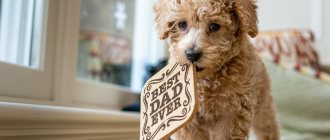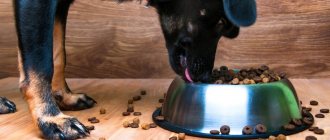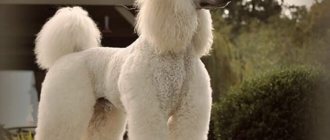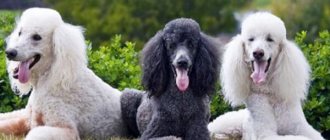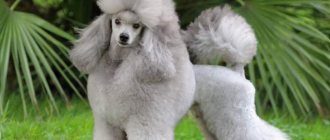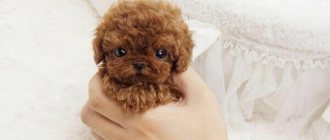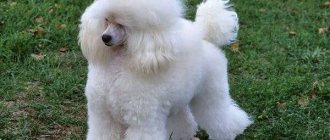The poodle is classified as a decorative dog. This is a unique breed that combines developed intelligence and attractive appearance.
Poodles rank second in the ranking of the smartest dogs in the world, second only to border collies. In fact, if you look at them from the outside, there can be no doubt about how smart they are.
Since there are different types of poodles, both large and small, we can only give an average of their height and weight. Height is 24-60 cm, and weight is 2.5-30 kg.
Such dogs live 14-18 years.
Along with their intelligence, poodles have developed security and watchdog potential. There is no doubt that they will easily sense any danger and notify about it.
Poodles are widely used in circus production, but now they have become favorites of families with children.
Origin story
The poodle is considered the national breed of France, but its origins are in Northern Europe . Initially, this breed was a hunting breed, its calling was to get game from the water and bring it to its owner.
It is no coincidence that poodle is translated from German as “splashing.”
The exact place where poodles originated is impossible to establish due to the fact that there are as many as 4 varieties in the breed..
But it is worth noting that images of dogs similar to poodles are already found in Greece on minted coins and bas-reliefs in the 4th-5th centuries. BC. The first descriptions of this breed are documented in the 12th-13th century.
The greatest popularity came to poodles in the 18th century . Moreover, dogs find their calling not only in the chambers of nobles, but also in the field, and as guides.
Interesting Facts
There are quite a lot of interesting things associated with the breed:
- Images of dogs resembling poodles were found on coins of Ancient Rome and Greece, in ancient tombs.
- Representatives of the breed served in Napoleon's army. The soldiers put dogs in backpacks so that if they were wounded, they would draw attention to the soldiers with a ringing bark.
- Composer Richard Wagner always took his beloved poodle to orchestra rehearsals. Hearing false notes, the pet began to bark.
- The breed was loved by many famous personalities: Prince Charles, Ludwig van Beethoven, Winston Churchill, Elvis Presley.
- Toy poodles were recruited into the Japanese police force. They work in a search and rescue team, since large dogs often cannot crawl under the rubble.
Character traits
Poodles have a kind and friendly temperament . They are responsive, intelligent and very loyal. Dogs of this breed always happily spend time with children, they will never offend them and will forgive any prank.
You can always take your poodle for a walk in the evening or sit in front of the fireplace. The dog will share any of your hobbies and adapt to it. Poodles love to be helpful to humans.
He will calmly treat a stranger . He will not show excessive aggression or wariness, but he will not rush to lick his hands and face. If something happens, the poodle will always come to the defense of its owner.
Poodles do not like human indifference and always take revenge on a careless owner. Be careful with it, otherwise you will end up with a pair of chewed slippers or favorite books.
The dog will easily fit into your rhythm of life . She is very sensitive to the mood of her owner, so be sure that she will rejoice and empathize with you.
It is also easy to offend a poodle, especially if it is done undeservedly . Be prepared for the dog to show character for some time. Show her a little affection and respect, and you will see that she never stopped loving you.
Expert opinion
Kozhevin Semyon Kirillovich
Expert dog handler.
“Poodles are distinguished by their intelligence and amazing ability to grasp on the fly. Therefore, this breed is recommended for purchase by beginners, because anyone can handle it. These dogs are loyal, affectionate and kind. But, if you are a busy person, then it is better not to choose a poodle. They need a lot of attention, a lot of walks and physical activity.”
Advantages and disadvantages
Advantages:
- Active and cheerful;
- Almost does not shed;
- Easy to train, quickly remembers his nickname, happily follows any commands;
- Characterized by kindness and calmness;
- Smart and non-aggressive;
- Can be kept in an apartment;
- Attractive exterior;
- Does not have a specific odor.
Flaws:
- Demanding of human attention;
- He has a lot of energy;
- A poodle needs to be walked a lot and often;
- The coat requires special care.
Reviews from poodle owners
Owners of poodles note that these dogs are highly trainable and there is no smell from them in the apartment.
Irene. I saw the first poodle in my life at school: a friend had such a dog. She was simply crazy about him, and her friend’s parents did an excellent “advertisement.” After 15 years, I began to look for a poodle for my family. I decided to take Toya because the apartment is small. I trained a 2-month-old puppy to wear a diaper in a month. Training the poodle was very easy. I'm not the best teacher, but my dog knows "Paw", "Sit", "Crawl", "Die", "Serve" and so on. Let's start doing agility. He enjoys playing with children (his own and other people's). I come to the conclusion that this dog is simply ideal - for me, for sure.
Alina. I can firmly say: this is the best family breed! I didn’t understand these dogs before, but that was until such a puppy appeared in the house. The main advantages, in my opinion:
- Has no smell. I judge around the apartment of friends who have a dachshund. Already at the entrance you can feel the persistent smell of “dog”. You won't find anything like this in a house where a poodle lives.
- The poodle does not shed - great for allergy sufferers.
- There is no aggression. None of the poodles (I already got several) have ever shown signs of aggression. Very gentle towards other animals and people.
- Amazing mind! They understand everything, it seems, even before you say it.
There is only one downside for me: grooming.
We offer you to watch a video dedicated to the wonderful breed of poodle dogs. We wish you pleasant viewing!
What types exist
There are several varieties of poodle :
| Species name | Description |
| Standard | This type is also called large or royal. The height of such a poodle is 45-60 cm. It requires special conditions, a small apartment is not suitable, it needs to be walked frequently. The animal is easy to train and has service and hunting potential. Discreet and proud, he will never do anything dirty. |
| Small | They are also called medium. The height of such poodles is 35-45. In character they are very similar to royal ones. They are distinguished by endurance, obedience, and accuracy. They will easily take root in an apartment, but also need walks and physical activity. |
| Dwarf | The size is 28-35 cm. They are also hardy, despite their touching appearance. They are jealous and require increased attention. They are loyal to their owner, but love to play and do mischief with children. |
| Toy poodle | Resembles a toy, height - up to 28 cm. They have a vulnerable and vulnerable character, they are proud. They don’t like to be treated like a thing, they can bite. They bark constantly and demand the owner's attention. They are also distinguished by their loyal and devoted character. |
| T-cap | The smallest and rarest representative of the breed, whose height is on average 18-27 cm and weight does not exceed 4 kg. They are distinguished by their especially cute appearance, but at the same time they have very fragile health. |
Breed standard
The toy poodle dog is small in size and weight. It was created with almost complete preservation of the parameters of the “standard”, that is, the large royal poodle. Despite its cute appearance, this dog has a lot of strength. He is agile, resilient and very nimble.
The body of the dwarf poodle is compact and harmonious. Weighs from 4.5 to 5.5 kg. The body weight of some representatives of the breed is in the range of 3.5-3.9 kg. They are also considered purebreds, but are much more expensive because they are born extremely rarely.
The height of the dog is from 27 to 33 cm. Errors are allowed. The shape of the body is rectangular, it is strong and elegant, slightly oblong. The back is shortened, and its narrowing is visible in the croup area. The lumbar region is well defined. The chest is oval, wide, and does not protrude.
The representative of the breed is very graceful, primarily due to the well-tucked up belly. His silhouette is graceful, clearly defined, not blurry.
The tail is straight, located high on the back. According to the standard it can be cropped. But individuals whose owners do not plan to register at show events do not need to have their tail docked; it will not become a hindrance to them at all. The limbs are set straight and symmetrically. The rear ones are wider apart than the front ones. The muscles on the thighs are strong and elastic.
The dog has a slightly elongated neck. The withers are well defined, the scruff of the neck is visible and palpable. The head is harmonious and has the correct shape. Very smooth transition from muzzle to forehead. Slightly elongated skull with a barely convex occipital protuberance. The muzzle is miniature. The jaw is powerful, the set of teeth is complete.
The ears are set low, in line with the eyes. Large, thick, hanging down. Covered with hair along the entire length. The lips are pressed tightly to the teeth, moderately moist. Has black pigmentation. A dark gum line can be seen along the entire length of the mouth. There may be pinkish spots of varying diameters on the oral folds.
The nose is large and black. The nostrils are wide. The eyes are dark, black or brown. The shape is oval, not planted deep. The miniature poodle in the photo looks like a big toy. He is sweet, handsome and charming. The coat is long, lush and curly. The shortest hairs are about 20 cm long. They are delicate to the touch. They cut their hair well.
Acceptable color options for poodles:
- Pure white.
- Pure black.
- Silver or blue.
- Brownish.
- Apricot.
In Russia, individuals with a hint of harlequin fur are often found. They are standardized only here.
Color variations
There are the following types of colors for a poodle:
- White is the most common color. Cream or apricot inserts on the coat are allowed, which will disappear with age;
- Black is the classic coat color for a poodle. It should be solid without any markings;
- Chocolate . The animal has a rich brown color;
- Silver . This color develops in a poodle over several years. Puppies are born black and become light gray later;
- Red . The color of the dogs' fur is mahogany;
- Apricot . The animal has the color of any variation of apricot. They may lighten with age, often becoming creamy as they mature.
In 2007, two more colors were recognized - harlequin (a combination of white and black) and black and tan..
Notes
- [www.stanleycoren.com/e_intelligence.htm Intelligent breeds, from Stanley Coren] (English)
- [www.akc.org/breeds/poodle/history.cfm AKC: Poodle history] (English)
- ↑ 12
[web.archive.org/web/20101106000641/www.fci.be/uploaded_files/172GB2007_en.doc FCI Standard No. 172 of 04/18/2007] (English) - ↑ 12
[www.ruspoodle.com/about/standard.php FCI Standard No. 172 dated 04/18/2007. Translation] - [redpoodlefcipetition.tripod.com/id2.html Recognition of Red color in the FCI Poodle Standard] (English)
- [redpoodlefcipetition.tripod.com/id15.html Petition for recognition of the Red color in the FCI Poodle Breed Standard]
- [huntingpoodle.ru Hunting with poodles]
Nutritional Features
A poodle can be fed with both natural products and industrial food. It is better to choose one that is saturated with vitamins and minerals to the maximum - this is premium and super premium food.
If you choose natural food, then your diet should include::
- Meat – 70% of the diet (beef, lamb);
- Sea fish once a week;
- Dairy products – kefir, cottage cheese, cheese;
- Vegetables – tomatoes, spinach, carrots, celery, beets, cabbage;
- Porridge – buckwheat, millet, rice.
Health and major diseases, life expectancy
This breed is prone to the following diseases:
- Overgrowth of the nasal passage;
- Heart diseases;
- Epilepsy;
- Double eyelashes;
- Tartar;
- Otitis;
- Pancreatic diseases and diabetes.
The life expectancy of poodles is on average 14-18 years .
IMPORTANT!
Most puppies are born healthy, without genetic abnormalities.
But don’t forget to still monitor your dog’s health to eliminate the risk of contracting acquired diseases.
Compatible with families
The Toy Poodle is compatible with a range of people and families. If the dog is familiar with other pets (such as dogs and cats), as well as people, then it will be able to get along with everyone. Although, this may take some time.
Socialization is a normal process that all animals need. After all, socialization at an early age will reflect the ability of Toy Poodles to be successfully socialized throughout their lives.
Since they are a delicate breed of dog, it is best to keep a close eye on them when playing with small children. This is to ensure that no unexpected injuries occur during the gameplay.
In general, the Toy Poodle tends to grow up to be a good-natured puppy with a friendly personality who loves people; they may even love people more than their canine companions.
Types of haircuts
There are the following ways to trim a poodle :
- "Lion" or "Continental";
- "Modern";
- "Bikini";
- Puppy;
- “English saddle;
- "Kennel";
- Dutch haircut;
- "Bichon".
Features of care
The poodle's coat requires the most careful care..
It needs to be cut every two months; it would be better if a groomer does this. You need to bathe your dog with shampoo quite rarely - no more than 4 times a year, but washing it in clean water can be done weekly.
Twice a month, do not forget to clean the poodle’s ears, sharpen the claws as they grow, and wipe the eyes every day with boiled water . A poodle needs to be brushed three times a week.
A poodle sheds only once, when it changes its puppy hair. During this period, the dog needs to be brushed every day.
Disadvantages of a shaggy pet
Experts involved in breeding dwarf poodles identify several negative qualities in the character, behavior and lifestyle of dogs. The disadvantages of this breed are:
- Long and difficult adaptation to new living conditions . Moving to a new house traumatizes the shaggy friend’s psyche. What can we say about changing the owner.
- Poodle health . The animal's body may suffer from the development of chronic diseases. Many pathologies are inherited. Your pet may need regular or lifelong medical care.
- The animal's fur needs constant and high-quality care . Taking care of your pet's physical needs includes bathing your pet weekly and trimming its coat once every two months.
- Dwarf poodles are afraid of loud noise and do not tolerate the company of unfamiliar animals or people.
- Dogs need regular physical training . Therefore, the owner of a poodle should allocate time for playing and training the pet. Moderate physical activity has a positive effect on the health of your shaggy companion.
Types of crossbreeds (mestizos)
There are the following types of poodle mixes:
- With St. Bernard;
- With Labrador;
- With Yorkshire Terrier;
- With a golden retriever;
- With a Maltese dog;
- With a cocker spaniel;
- With Shih Tzu;
- With collie.
How to choose?
First, decide: what size poodle do you need?
Based on how big your apartment is and how many people live in it, whether there are children.
Already in the nursery, observe how the poodle puppies behave. Choose an active baby who doesn't get scared, hide, or be overly aggressive.
Examine it:
- The eyes must be clean;
- There should be no unpleasant odor from the mouth;
- There should be no leakage from the ears;
- There should be no rash on the stomach;
- A healthy puppy has hair without bald spots, clean;
- The limbs must be intact, the tail without kinks.
The optimal time for acquisition is 2-4 months.
Puppies
An important point in purchasing a pet is its choice, and this is not an easy task. To avoid making a mistake, it is recommended to follow some rules.
Choosing a puppy
The first visit to the breeder should not end with the purchase of the first quadruple you like. It is worth spending some time on observations, namely, paying attention to how the young animals feed, play, and evaluate external data.
The choice is made in favor of a mobile animal. The smallest in size, characteristic of a particular variety of poodle, may be the weakest in the litter, which will inevitably affect health.
Healthy puppies have clean eyes and no discharge or traces of tears. Mobility, movements without signs of lameness, curiosity - these are the qualities that dogs that do not have health problems are endowed with. The presence of matted hair under the tail indicates problems with digestion.
Price
Professional breeders offer to purchase puppies of this breed at prices ranging from 25,000 to 50,000 rubles. It all depends on how much is invested in the dog and its provision. Conscientious owners purchase high-quality food and also conduct regular veterinary examinations of their pets. If there are titled parents, the price of a puppy often doubles.
Dogs without pedigrees are offered in the range from 12 to 18 thousand rubles. A lower price may indicate a defect in the pet or a serious illness.
